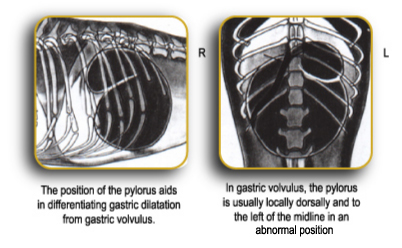
To me BLOAT was something other people’s dogs got, and quite frankly I wasn’t sure how it could occur if the other people were taking what I thought were all the right precautions: moistening their dog’s food, elevating the food bowls, not allowing their dogs to drink a lot of water right before or after their meal and never allowing their dogs to have any strenuous activity before or after eating.
It seemed at each Search & Rescue seminar and training session I attended there was a lecture given on GDV and how to recognize it. I had even taken some training on how I would treat gastric bloat in the field if I was out on a search miles from help. Not that I really felt I could put a needle in my dog’s side and feel comfortable releasing the terrible gas that was causing the problem. But I knew it would be an emergency, a truly life and death situation if one of my dogs were to get it. Any time wasted before I could get to a vet would be my worst enemy. The truth is, they say that up to 40 percent of GDV victims die for lack of emergency veterinary care within six to 12 hours following its onset.
So this past February evening when I saw my 10 year old black Lab, Cally, walking towards me obviously in great pain and with a distended stomach I knew we were in trouble. But my mind kept replaying the events of what transpired just fifteen minutes earlier- Cally happily coming down the stone pathway greeting me with her smile and wagging tail as she knew it was feeding time. She had spent the previous two hours lying out in the gardens enjoying an unusually sunny February afternoon. She hadn’t been doing anything strenuous or active.
She had made a bee-line to her kennel and eagerly gone on in. Then I shut the gate and gave her, her usual dinner. I could hear her gulping it down as I turned to go feed the rest of the gang. Cally has always been a vivacious eater, ever since I got her some three years ago. We had even gotten to the point of putting a tennis ball or round toy in her bowl to try to slow her eating down so she would have to eat around it. She was generally fed first as her tension and excitement would grow if she knew someone was eating before her. After dinner, we tended to walk her after everyone else for her last potty for the night because if the others were out of their runs, she’d just go in each run and lick their bowls. You’d think we were starving this dog, but she was a healthy happy sweet black Lab.
Miraculously and for the first time I can ever remember her gate didn’t fully close, allowing Cally to come find me. But the sight of her coming towards me in such pain changed my thoughts from flashbacks into reality. I rushed her into the house but it was clear that even normal movement was difficult and painful. She was restless and anxious, not able to lay down yet uncomfortable standing. When I touched her distended abdomen she winced and grunted in pain. I kept telling my daughter “I think Cally is bloating, we’ve got a problem!” As I dialed the vet, she repeatedly tried to vomit with little success.
Thankfully, it was 5:15pm and the vet’s office was still open. I told them I was pretty sure that Cally was bloating and I was coming right in and to be ready. This is when the normal thirty minute drive to the vets gets shaved to seventeen as you drive 80 mph taking the highway, going through every yellow light.
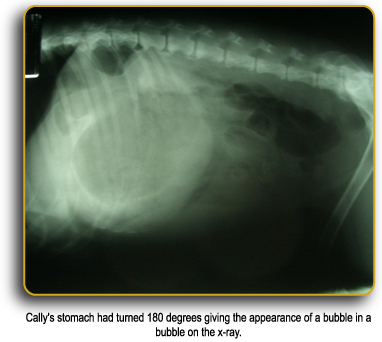
The vet’s office was ready for us when we arrived, and had a treatment room available. After giving a physical exam which revealed an enlarged spleen, the first thing the vet did was to take an x-ray. This x-ray confirmed my worst fears. She did have bloat, but we had caught it early and the stomach had only twisted 180 degrees. She would have to have emergency surgery to correct the stomach and to tack it down to prevent it happening again. We wouldn’t know if there was any damage to her other organs until after surgery. The vet was cautiously hopeful but said that there still could be complications.
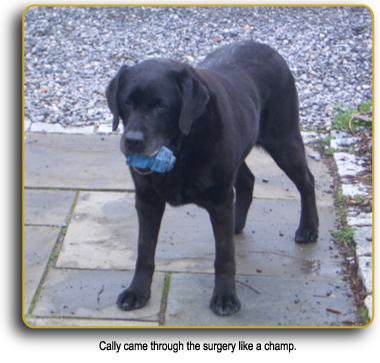
Our early detection had kept any damage happening to her other organs. After a few nights stay at the clinic, Cally was able to return home on a restricted food and activity regime. Now four weeks after the bloat episode, the only evidence of the whole ordeal is her shaved belly and the marks there where her stitches were. Her spirits are terrific and she has that same smile and happy face. However, inside me, I’ll always have the big “B’ on my mind, especially at feeding time.
What is GDV or Bloat?
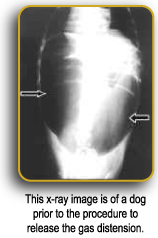
Gastric dilatation-volvulus (GDV) or bloat as it is commonly referred to, is the severe expansion or gastric dilation of the stomach which then twists or rotates (volvulus) on itself. In bloat, due to a number of different and sometimes unknown reasons, the stomach fills up with air and puts pressure on the other organs and diaphragm. Filled with air, the stomach can easily rotate on itself. Not all dogs that have a gas buildup and resultant dilation develop the more serious and life threatening volvulus. Roughly twenty five percent of bloat cases are caused by the gastric dilation. The remaining seventy-five percent are due to gastric volvulus, when the stomach twists more than 180 degrees on its long axis.
When the stomach twists, sphincters that control the opening and closing of the two important passageways into and out of the stomach are closed off—one leading from the esophagus to the stomach, and the other leading from the lower end of the stomach to the small intestine. Once this torsion occurs, it cuts off the inflow and outflow from the stomach preventing gases from escaping. Since the stomach gasses cannot get out, they expand and the pressure causes the abdomen to become distended. Normally the buildup of gas would be relieved by vomiting or belching, but because of the torsion this can’t happen.
The Risk
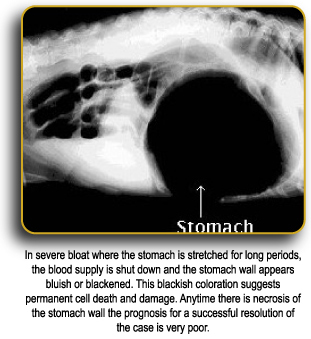
With gastric torsion, the blood supply is cut off and the dog’s condition begins to deteriorate very rapidly. If this painful condition is not treated within one to two hours, it is life-threatening. Digestion ceases, causing the accumulation of fermenting food and accompanying bacteria in the stomach. The bacteria cause inflammation of the stomach wall, which can result in tissue death (necrosis) unless treated promptly. The bacteria can also pass into the dog’s bloodstream, promoting the formation of blood clots that may impede blood flow to the heart and cause the dog to go into shock.
Meanwhile, if the bloating continues and the oxygen supply to the stomach and nearby organs- primarily the spleen and pancreas- is not restored quickly, the stomach may rupture. The suffering dog may die from a combination of factors: tissue damage, a ruptured stomach, kidney failure, respiratory insufficiency, cardiac failure and shock. Even dogs that survive surgery and seem to be recovering often succumb to endotoxic shock hours and even days after the procedure. It is estimated that even with treatment, at least 35% of the dogs with gastric dilatation and volvulus die.
What Causes Bloat
There is not one particular activity that leads to the development of bloat. It appears that it occurs as a combination of events. Dr. Larry Glickman, an epidemiologist at the Purdue University School of Veterinary medicine, conducted a five year controlled study on canine bloat, beginning in 1994. He followed 1,914 dogs that did not have a prior history of bloat. Eleven large and giant breeds were represented in the study. From this study, several risk factors were identified:
-
One primary risk factor is that its incidence is closely correlated to the depth and width of the dog’s chest. The dogs with the greatest risk of developing bloat have chests that are deep and narrow. This can be evaluated by measuring the depth and width of the chest, and then the depth is divided by the width. The depth-to-width ratio reflects the amount of room there is for stomach movement in the abdomen, behind the ribcage. The higher the number, the more room there is for movement. Dogs with more room have a greater risk of developing bloat.
-
Lean dogs were found to be at higher risk than overweight dogs. It is hypothesized that this is because fat takes up space in the abdomen. The lack of fat in the abdomen of a lean dog creates a basic situation similar to that of a dog with a deep and narrow chest. A lean dog has much more room in the abdomen for the stomach to move around than a fat dog has.
-
Risk is also higher for older dogs. For large breeds, the risk of developing bloat goes up 20 percent each year after the age of five.
-
First degree relatives of dogs that have bloat have a 63 percent greater risk of developing bloat themselves.
-
Dogs that eat quickly have a 15 percent higher risk of developing bloat. This may be related to the increased swallowing of air. (Studies of the stomach gas that occurs in dilation have shown that it is similar to the composition of normal room air suggesting that the dilatation occurs as a result of swallowing air.)
-
The raising of the food and water bowls was found to actually increase risk by 110 percent.
-
Fearful, nervous, or aggressive dogs had a much higher incidence of bloat than dogs perceived by their owners as having happy temperaments.
-
Stress can also be a precipitating factor, and many dogs bloat after recent kenneling, or a recent long car ride.
-
A slightly higher percentage of males than females developed bloat.
-
Several diet-related factors were associated with a higher incidence of bloat. These include feeding only dry food, or feeding a single large daily meal. Dogs fed dry foods containing fat among the first four ingredients had a 170 percent higher risk for developing bloat. Dogs fed dry foods that were moistened prior to feeding and that contained citric acid had a 320 percent higher risk for developing bloat. Conversely, feeding a dry food containing a rendered meat-and-bone meal decreased risk by 53 percent in comparison with the overall risk for the dogs in the study. Mixing table food or canned food into dry food also decreased the risk of bloat.
-
Dogs that have bloated were found to have a much longer hepatogastric ligament which normally when not stretched would maintain the stomach’s normal position in the abdomen. As for feeding one large meal a day, this can weigh down the stomach and stretch the hepatogastric ligament. This could also explain why bloat risk increases in older dogs since muscles tend to weaken with age.
Several popular theories regarding bloat were not substantiated during the study. They were:
1. There was no correlation of bloat risk to exercise before or after eating, as most dogs bloated in the middle of the night with an empty, gas-filled stomach.
2. There was no correlation to vaccinations.
3. There was no correlation to the brand of dog food consumed.
4. There was no correlation to the timing or volume of water intake before or after eating.
From the research performed to date, we can list several factors that, added together, can characterize the typical dog that develops bloat; a deep and narrow chest, leanness, a relative that has had a bloat episode, eating quickly, a dry-food diet, a single, large daily meal, and a fearful, nervous, or aggressive temperament.
What are the Symptoms
The earliest signs typically include restlessness, anxiety, pacing and whimpering. The dog will show no interest in water or food and most likely will have unproductive retching and vomiting. Salivating or drooling is common. The dog’s abdomen will become visibly distended and have rapid shallow breathing. The dog may also begin to drool heavily. If the dog’s condition continues to deteriorate, especially if volvulus has occurred, the dog’s gum tissue and other mucous membranes may become pale, and its heart will beat rapidly At this point the dog may die within hours unless it receives immediate treatment.
How is GDV Treated?
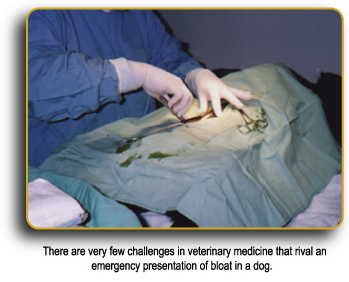
Approximately 35 percent of dogs that develop bloat die or have to be euthanized. This can be due to shock, arrhythmia (fatal irregular heart beats), or to rupture or death of the stomach wall. Studies have shown that 40 percent of dogs that bloat have some heart arrhythmia during the bloat episode. Affected dogs usually receive fluids and shock therapy at the time of treatment in an attempt to control this.
The stomach is decompressed either by passing a tube through the stomach or if a tube cannot be passed due to the torsion, inserting a large diameter needle into the stomach right through the abdominal wall to help relieve the pressure. After the animal is stabilized, x-rays are taken to determine whether or not a volvulus has occurred. If it has occurred, then emergency surgery is required to correct the stomach. The doctor will need to incise the stomach to dissipate the gas and bring the stomach back to a reasonable state of size and pressure. If a volvulus is present, the spleen is also involved and often its blood supply becomes strangulated. Some dogs may also require removal of a damaged spleen or a portion of the stomach wall.
When the stomach contents are emptied through the stomach incision, the stomach wall is finally sutured closed. If a volvulus is present, the surgeon will reposition the stomach into its normal anatomical position. Then the stomach tube is inserted through the mouth into the stomach and additional flushing and antibiotic administration is done. Before closing the abdominal incision, the surgeon usually will tack (affix with sutures) the stomach to the abdominal wall to prevent reoccurrence.
Gastropexy, or ‘tacking’ the stomach is an important aspect of bloat surgery. Studies have shown that 76 percent of dogs that do not have a gastropexy will bloat again; more than half will bloat within three month. Only six percent of dogs that have had a gastropexy have another bloat episode. ogs that have gastric dilation without the volvulus should have a gastropexy performed as soon as possible to reduce dilation and volvulus from happening in the future.
Depending on the severity of the episode, the dog may stay in the hospital several days to be monitored and treated as needed. Unfortunately, some dogs will die in the postoperative period from complications. Even with treatment, it is estimated that at least 35% of the dogs with gastric dilatation and volvulus die.
How is Bloat Prevented?
Canine bloat, or gastric dilatation-volvulus (GDV), is the number one cause of death for several of the large and giant breeds. So how do we prevent it? As with many disorders, selective breeding is the best prevention. Keep in mind that dogs do not inherit bloat; they only inherit a predisposition for the condition. There is no single, major gene that controls bloat. But because of the genetic link involved with this condition, prospective pet owners should question if there is a history of GDV in the lineage of any puppy that is from a breed listed as high risk. Perhaps the best selective tool against bloat is the chest-depth to chest-width ratio. Dogs that have lower ratios and whose littermates have not bloated are the best breeding candidates.
In addition, the following recommendations should be followed:
- Large dogs should be fed two to three times daily, rather than once a day.
- Dogs should be fed individually and if possible in a quiet stress-free location.
- Try to discourage your dog from eating rapidly. Place a tennis ball in the bowl so that the dog has to eat around it or place the food on a cookie sheet to make the dog have to fish around for the food.
- Schedule the feedings so that you are present following the dog’s meals in case any signs of gastric disturbance appear. Don’t feed the dog just before you go off to work or turn in for the night.
- Diet changes should be made gradually over a period of three to five days.
- Owners should be aware of the early signs of bloat.
- As a preventive measure, owners may want to consider preemptive gastropexy. The operation can be done in conjunction with other abdominal surgery, such as spaying.
- Owners should develop a good working relationship with their local veterinarian in case emergency care is needed.
Summary:
There are some emergencies that you never expect to happen to you and your dogs, but as Lab owners, we need to be very aware of the risk of bloat. If this painful condition is not treated within one or two hours, it is life threatening. Understanding it’s prevention, it’s symptoms, and need for prompt emergency treatment, will help reduce the risk of mortality if your Lab develops the big “B”.
.jpg)






